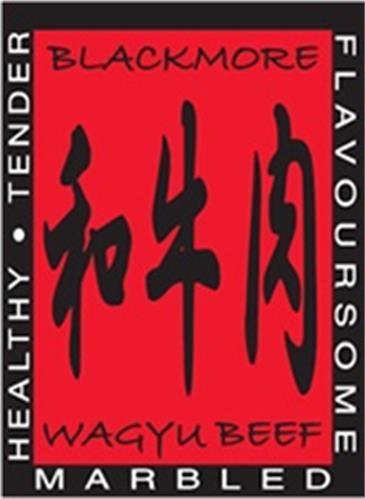
Blackmore Wagyu
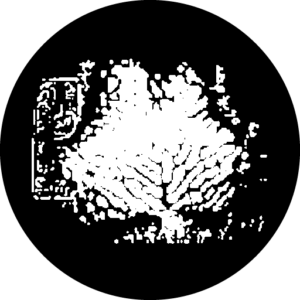
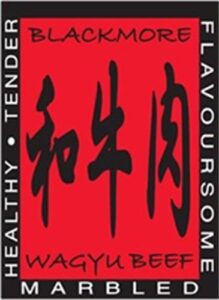
Australian breeder David Blackmore founded Blackmore Wagyu in 1988, after having been in the embryo export and import business since 1979. He previously focused on sourcing elite dairy and beef cattle genetics from North America. David was introduced to Wagyu while importing North American genetics to Australia. The Blackmore team and herd has grown immensely since its start in 1988. The fullblood Wagyu program now numbers close to 4,000 head of fullblood cattle, and another 600 Angus recipients for E.T. (embryo transfer). The operation spans five farms: three are breeding farms, one is a backgrounding farm, and one is a specifically designed feeding facility. Of the five farms three are irrigated, a key factor given the rising number of droughts seen in Australia. From the beginning of the business in 1988 David Blackmore has guided the business every step of the way and through many obstacles and challenges.
Blackmore Wagyu is a family owned and operated business that has grown into one of the world’s leading producers of high-quality Wagyu beef. David and his wife Julie have a son and daughter in the business now, too. Their son Ben is now the CEO of Blackmore Wagyu and their daughter Danielle is their Business Analyst. Each of Blackmore Wagyu’s five farms also has its own farm manager. In total, the family business has 15 employees. The Blackmore Wagyu team is essential for the business to run successfully and does a tremendous job enabling their genetics to reach their highest potential.
In a normal year the breeding herd is managed in a grazing system. They spend all year on pasture with a small amount of supplementation of grass hay during the winter months. This year, however, has been one of the worst droughts in Australia’s history. Due to this, David is feeding the entire herd by hand on a daily basis. Calves are normally weaned at 6-8 months of age then backgrounded until feedlot entry weight (300-350 kg or 660-770 lbs.) at approximately 10 months of age. This year they are weaning at four months because of the drought. The herd’s replacement heifers are weaned on the same regime, but are then backgrounded on a different ration with slightly higher protein and less energy. The purpose of this is to grow a large frame that allows heifers to breed at 15 months of age and 400+ kg or 880+ lbs. There is an established plan and goal for each animal in the Blackmore production system.
The steers are fed three different rations depending on age and stage of feeding. These are a backgrounder, grower, and finisher ration. The steers typically stay on the backgrounder ration for the first 60 days in the feedlot and at 12 months of age, weighing 400+ kg (880+ lbs.). They are then shifted to the grower ration. Steers stay on the grower ration until about 18-20 months of age at which point they weigh 600- 650 kg (1,320-1,430 lbs.). This is when they are shifted to Blackmore Wagyu’s signature finishing ration. Steers are fed a total of 600-650 days altogether in the feedlot from their start at 10 months of age. They aim for live weights on the steers of between 850-900 kg (1,870-1,980 lbs.). In recent years, they have been achieving 1,000 kg (2,200 lbs.) live weight and carcass weights in excess of 600 kg (1,320 lbs.) on many steers. The rations fed are a key factor, along with genetics, in achieving these impressive results consistently.
The rations that are fed at Blackmore Wagyu are “classified” information, however they can be described as Japanese-style adapted to available Australian commodities and have been developed over 15 years. Blackmore beef draws comments from chefs around the world that it has a distinct flavor, which sets it apart from other products. This often draws comparisons to the secret recipes of Coca Cola and KFC (Kentucky Fried Chicken), and it gives Blackmore beef an edge in the marketplace. Blackmore Wagyu has more demand than they can meet for their beef.
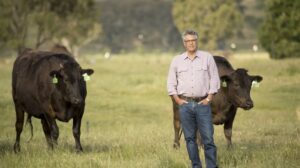
David Blackmore with some of his Fullblood Wagyu Cows
All the beef produced through the Blackmore Wagyu program is sold through their branded beef line. This is the backbone of the Blackmore Wagyu business. Blackmore beef is sold domestically in Australia and is also exported globally to customers around the world. The goal of producing the best carcasses possible is what drives David’s breeding and reproduction programs.
As David made many trips to Japan and did a lot of “homework” on what to buy and why when was selecting the Wagyu genetics that he wanted to begin his herd with. Ultimately, he decided he would apply similar criteria to what he applied to Holstein dairy cattle when looking for genetics to import into Australia. Since his cattle would be primarily grazing in Australia and not standing eating at a feed bunk, they needed to be able to consume large volumes of grass and walk up to three to four miles per day. David therefore was looking for cattle with big capacity, deep heart room, robustness, good milk, and that were structurally correct. David found these cattle in the Takeda herd with the idea that he would then cross them with other available genetics. David notes “My herd is made up of Takeda cow families, and then I have line bred to the most famous cow in Japan called Kikutsuru (the Hyogo cow) who is credited for having the most influence in increasing size, constitution, and meat quality in Japanese Tajima bloodlines”. Kikutsuru has had four grandsons exported from Japan that have been used to line breed in the Blackmore program. They are JVP Fukutsuru 068, Westholme’s Kitatsurukiku Doi (007), Kikutsurudoi TF 146, and Kimifuku 3. The first three are maternal descendants of the Hyogo cow, an important factor in many breeders decisions for maximizing the potential of genetics.
From this foundation, the Blackmore herd has operated an intensive embryo transfer (E.T.) program for many years. They are producing over 2,000 embryos per year. Half of these are used within their own program in their Angus recipients and fullblood herd while the other half are sold for export. David in recent years does not sell any of his own genetics within Australia. The donors for this program are all in the top 5% of the herd and selected on a combination of pedigree, phenotype, progeny results, flushing ability, and carcass results. This program assists in maximizing genetic progress within the herd and is a key part of the larger reproduction and genetics program David operates.
The breeding herd calves year-round because the customers of their branded beef line expect product every month of the year. All the cows get one artificial insemination (A.I.) in a synchronized CIDR (vaginal progesterone insert) program 60 days after calving and then the back-up bull goes in 15 days after A.I. These back-up bulls are usually the same bulls used in the A.I. program. Now, with the genomics project Blackmore has developed within herd, they are able to identify young bulls with high GEBVs and good accuracy to make faster rates of genetic gain by decreasing the generational interval within the herd. David is especially excited about the potential the Genomic Estimated Breeding Values (GEBV) system brings to the program.
The GEBVs just mentioned are a product of the genomics research project the Blackmore herd has been coninuing for the last four years. This has allowed for the calculation and publication of Genomic Estimated Breeding Values (GEBV). David now has over 15,000 animals in his database, with 8,500 of these having GEBVs.
The database consists of 4,500 officially graded carcasses. David inspects each carcass individually with a three-generation pedigree and the carcasses are graded by independent AUS-MEAT graders at the 10/11th rib. Every Blackmore carcass is graded for all available official government graded results, including: Marble Score (MS), Carcass Weight (CWT), Eye Muscle Area (EMA), Fat Color (FC), P8 Fat, and Rib Fat. The Blackmore herd is achieving inspiring averages for these traits of a 9.1 MS, 424.8 kg CWT, 93 cm2 EMA, 0.5 FC (0 is the best score possible), 18.0 cm P8 Fat, and 22.2 cm Rib Fat. The GEBVs of the herd can be used to evaluate each animal by either adding or subtracting that animal’s GEBVs against the herd average. The impressive herd averages listed above are only achievable through the program’s combination of precise management practices, specifically designed rations, and the elite genetics carefully bred over more than 30 years. The GEBVs are highlighting the strongest cow families in the herd and are allowing for the identification of previously unrecognized elite families. The GEBV research will only help increase the quality of every carcass produced at Blackmore Wagyu.
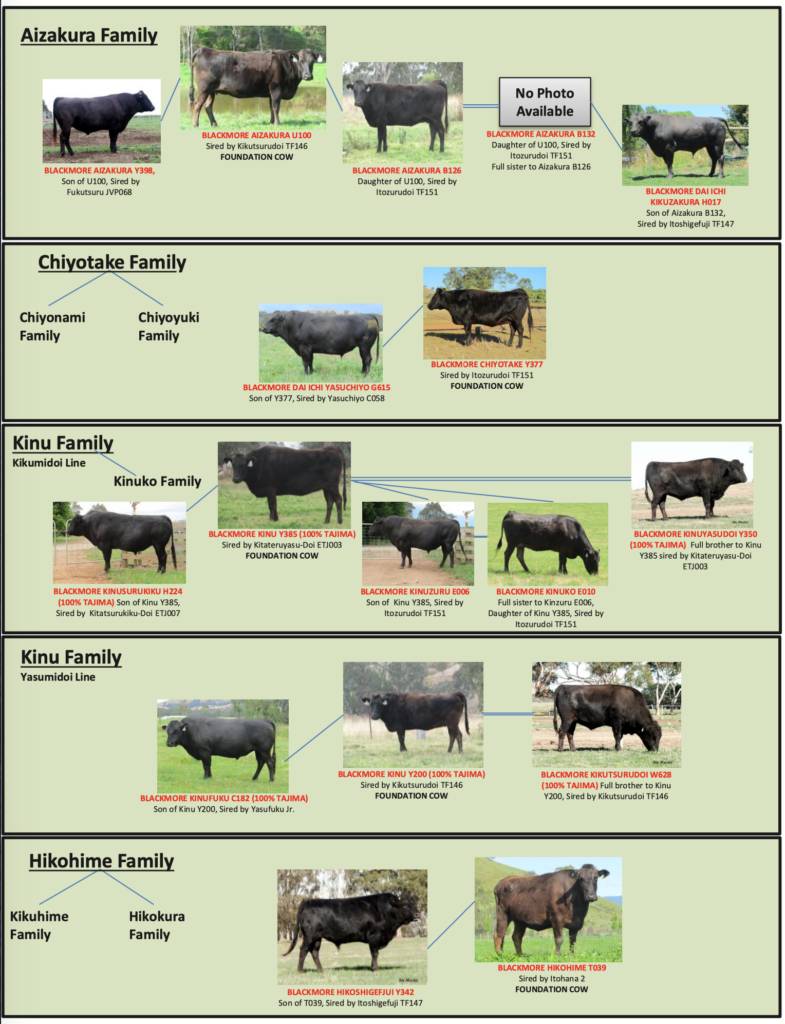
Blackmore Wagyu Cow Families
The overall goal of the genetics and breeding program at Blackmore Wagyu is to produce the highest quality carcasses possible. This is driven by their customers who are in the niche fine dining restaurant market and require the same high-quality product every month of the year. David’s general breeding philosophy in mating decisions is to assess the cow and then use a sire to correct her faults or strengthen her weaknesses. The breeding program from a carcass standpoint is looking to maintain their marble scores while putting equal emphasis on increasing EMA and CWT. Aside from the carcasses, David is always looking for robustness, constitution, structural correctness, and milk in his cattle. These are important traits both in the paddock and the feedlot.
The breeding program utilizes GEBVs to assist in identifying the strengths and weakness of the cattle. However, these are not the only genetic tests that the herd is working with. Every animal is tested for recessive genes with this information used in mating decisions. All animals are parent verified to their sire and dam and inbreeding coefficients are calculated on all cattle. Currently, new genomic tests for maternal and feed efficiency traits are being developed in their genomics research. All of this comes together to help create the world-class genetics that make up the Blackmore herd. Within this world-class genetics program some cattle are proving to be superior to the rest.
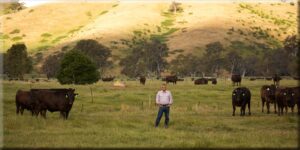
Fullblood wagyu on one of the Blackmore Farms
Multiple strong cow families (maternal lines) are achieving great things that are well above the already impressive herd averages. These maternal lines include the well-known Chiyotake family, the Aizakura family who is the historical star of the Blackmore herd, and the rare Blackmore branch of the Kinu family. These three cow families have produced successful proven sires in the Blackmore program such as Blackmore Dai Ichi Yasuchiyo G615 (Chiyotake), Blackmore Dai Ichi Kikuzakura H017 (Aizakura), Blackmore Aizatsurudoi Y398 (Aizakura), and Blackmore Kinusurukiku H224 (Kinu). These sires are being used to form the next generation of elite sires and dams in the Blackmore herd.
The Aizakura cow family has been one of the most successful and prolific families in the herd from the start. Foundation cow Takeda Farm Aizakura U100 now has over 3,000 descendants born on the Blackmore farm. This is a result of her own remarkable E.T. production and the success of her sons and daughters as A.I. sires and donor dams producing superior carcasses. Takeda Farm Aizakura U100 possesses an incredible performance record, having produced 24 carcasses that all graded AUS-Meat marble score 9+ (the highest possible grade). She is one of David’s favorite cows ever (now 22 yrs. old) and excels in structural correctness, milking ability, and fertility. Her son, Blackmore Aizatzurudoi Y398 was one of the first super sires that David bred. Y398 is a son of JVP Fukutsuru 068 and is line bred to the Hyogo cow through 068 and his maternal grandsire TF 146. He has been used to create excellent breeding cows with great milking ability and heavy carcass weights that have consistently graded 9 or 9+ MS. His raw herd stats include 28/36 carcasses MS 9 and 20/36 MS 9+ with a high daily gain (DG) of 0.79 kg/day (1.79 lbs. /day). That is a higher DG than popular foundation sires TF 151 (DG 0.76) and TF 147 (DG 0.77) have achieved in the herd based on David’s published data on foundation sires from 2013. Both U100 and Y398 have relatively average GEBVs now due to the rapid rate of genetic progress the breeding program has been able to achieve, however they are at +0.1 and +0.0 MS plus a +8.4 and +19.6 HCW GEBVs respectively. Y398 has recently shown some impressive carcass results in Mayura Station’s well-known short, 300 day fed fullblood Wagyu program, averaging an 8.33 MS and 420.6 kg HCW on six carcasses.
The Aizakuras are a premier cow family in the Wagyu breed and have produced great sires in a variety of herds. The Macquarie Wagyu program’s top cow, Macquarie Wagyu C1155, is from the Aizakura family. Her full brother is Macquarie Wagyu C1176, the highest Marble Score (MS) sire on Breedplan. TF Itohana 2 is from the Aizakura foundation cow Aino 6 and has been widely used and praised for his overall ability to make quality cows and great carcasses. The top selling bull from the 2017 AWA Elite Wagyu Sale was an Aizakura family product, Mayura L0010, a Mayura Itoshigenami JNR son who sold for $105,000. The 2018 Elite Wagyu Sale saw Macquarie Wagyu M0549, a Michifuku son of the top Macquarie cow C1155, sell for $80,000. Therefore, as you can see, this family has a track record of success around Australia; and TF Itohana 2 around the world.
The current stars of the Aizakura cow family in the Blackmore herd are full sisters Blackmore Aizakura B126 and Blackmore Aizakura B132, the latter of which has produced the key proven sire Blackmore Dai Ichi Kikuzakura H017. Both cows are sired by the legendary TF 151 and out of foundation cow Takeda Farm Aizakura U100. TF 151 still maintains good GEBVs in the Blackmore herd of +3.0 EMA, +22.6 HCW, +0.4 MS and a raw stats line of 0.65 kg (1.43 lbs.) DG, 298/320 carcasses MS 9, 271/320 carcasses MS 9+, and a 99.25 cm2 (15.38 in2) EMA. Successful proven sire Blackmore Dai Ichi Kikuzakura H017 is a son by TF 147 and has the herd’s highest HCW GEBV at +42.5. David says he is a valuable outcross sire within the herd with 87.5% Itozakura bloodlines and is used to increase size, robustness, constitution, fertility, and milk in females while maintaining MS with his +0.1 MS GEBV. To top it off, H017 has extremely high accuracy GEBVs of 92% for EMA, 89% for HCW, and 92% for MS. This sire will be a valuable tool for corrective mating in the Blackmore herd for years to come.
The next great family in the Blackmore herd is the Chiyotake family. In this family, we find David’s current favorite cow in the herd, Blackmore Chiyotake Y377. She has an elite sire stack of TF 151 x TF 148 x TF 147 x Itohana 2 x Chiyotake 8A. She is a sound 16-year-old cow and still producing embryos for David. She is arguably the premier bull dam in the herd, producing all-round super sire Blackmore Dai Ichi Yasuchiyo G615 and carcass specialist Blackmore Chiyofuku K733. On six carcasses she has a 0.73 DG, 6/6 MS 9+, and 94.9 cm2 EMA. Her GEBVs are extremely impressive sporting a +4.4 EMA, +13.0 HCW, and +1.0 MS. She also has great P8 Fat and Rib Fat GEBVs of -0.2 and -1.3 (negative numbers are ideal) which have a large impact on overall yield and profitability.
Her son, Blackmore Dai Ichi Yasuchiyo G615 is a staple of the Blackmore breeding program that David uses to improve all aspects: breeding females, carcass quality, and weight, and is a sire of next generation breeding bulls. G615 is sired by Blackmore Yasuchiyo C058, another one of the best all-round bulls David has bred to date. C058 is a World K’s Yasufuku Jr son and has some great raw data of 0.70 kg DG, 172/216 MS 9, 94/216 MS 9+, and 94.9 cm2 EMA. Blackmore Dai Ichi Yasuchiyo G615 is 72.25% Tajima, and he is the largest bull the Blackmore program has bred to date weighing in at over 1,000 kg (2,200 lbs.). His high, yet balanced, GEBVs are +1.3 EMA, +2.8 HCW, +1.2 MS, -3.8 P8 Fat, and -2.2 Rib Fat. This combination of elite and high accuracy GEBVs which are all over 90% for all major traits is an asset to the Blackmore herd and he is an integral part of the herd’s breeding program. The maternal brother to G615 is Blackmore Chiyofuku K733, who is a World K’s Michifuku x Blackmore Chiyotake Y377. He has top-notch EMA and MS GEBVs of +9.2 and +0.9, respectively.
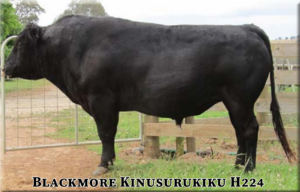
Another cow family making waves in the Blackmore herd is the Kinu cow family. The only 100% Tajima cow to have been exported from Japan was Kinu 1. She was from the Okudoi line of Tajima, which is different from all other exported Tajima genetics that were from Nakadoi and Kumanami lines. The Blackmore Kinu family is formed off the foundation of a JVP Kikuyasudoi 400 daughter of Kinu 1, Blackmore Kinu T077. She was then crossed with both Kikutsurudoi TF 146 and Westholme’s 003 Kitateruyasudoi to make two separate lines within the herd. Following this, Blackmore used grandsons of the Hyogo cow, 007 Kitatsurukikudoi, Kikutsurudoi
TF 146, and JVP Fukutsuru 068; plus TF 151 Itozurudoi and Kitateruyasudoi 003, on these daughters of Blackmore Kinu T077. This cow family does not make up a large percentage of the Blackmore cow herd, but it does not need to be large in numbers to achieve its primary purpose. This is because it is primarily used to breed sons that are either used as terminal sires to breed fullblood carcasses or to breed next generation sires.
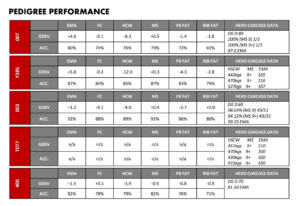
H224’s Performance Pedigree
The Kinu family has produced multiple successful donor dams in the Blackmore herd. The carcass data from these cows is extremely impressive. Foundation cow Blackmore Kinu T077 has produced four carcasses all with a 9+ MS, HCWs of 430 kg (946 lbs.) to 470 kg (1,034 lbs.), and EMA of 100 cm2 (15.5 in2) to 110 cm2 (17.05 in2). Her daughter by Kitateruyasudoi 003, Blackmore Kinu Y385, has produced three carcasses all MS 9+ with HCWs of 442 kg (973 lbs.), 470 kg (1,034 lbs.), 527 kg (1,159 lbs.), and EMA of 105 cm2 (16.28 in2), 116 cm2 (17.98 in2), and 107 cm2 (16.59 in2). Then, Y385’s daughter who is sired by TF 151, Blackmore Kinuko E010, has produced one carcass which was MS 9+, 470 kg (1,034 lbs.) HCW, and 91 cm2 (14.1 in2) EMA. The proven carcass performance of these cows is not all they have to offer, as they are also successful bull dams. They have produced top sires in the Blackmore herd such as Blackmore Kinuyasudoi Y350, Blackmore Kinuzuru E006, Blackmore Kinuzurudoi K730, and Blackmore Kinusurukiku H224.
The second “super” proven sire bred in the Blackmore program after Y398 was Blackmore Kinuzuru E006. He has an exciting sire stack of TF 151 x 003 x JVP 400 x Kinu 1. His dam is the above-mentioned proven bull mother, Blackmore Kinu Y385, and he is a full brother to Blackmore Kinuko E010 (carcass results above). This full sister has produced a promising young sire in the Blackmore herd, Blackmore Kinuzurudoi K730. This bull is sired by Blackmore Aizatzurudoi Y398, and with his dam being E010, he is a combination of the two cow families that made David’s first and second “super” proven bulls (Aizakura and Kinu cow families).
This brings us to the current star sire of the Kinu family in the herd, Blackmore Kinusurukiku H224. He can be described as a true carcass specialist and is a leading GEBV sire in the Blackmore herd for MS, EMA, P8 Fat, and Rib Fat. The GEBV line he boasts is +12.5 EMA, -9.9 HCW, +1.3 MS, -5.5 P8 Fat, -4.4 Rib Fat. His dam is the super cow Blackmore Kinu Y385, and he is sired by the Westholme bull Kitatsurukikudoi 007 (Hyogo cow grandson).
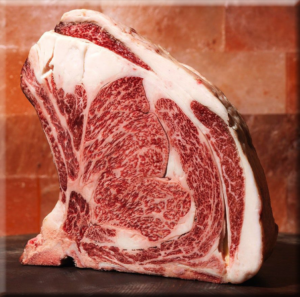
H224 carcass from Beefcentral.com’s Article
This produces a solid sire stack of 007 x 003 x JVP 400 x Kinu 1, a pedigree that is 100% Tajima. A 2017 Beefcentral.com article features a spectacular H224 sired carcass achieving up to $500/kg at Victor Churchill’s famous butchery in Sydney, Australia. This carcass had a MS 9+, 128 cm2 (19.8 in2) EMA, and 457.5 kg (1,007 lbs.) HCW. This illustrates the world class carcasses that this sire is routinely producing for the Blackmore Wagyu program. David says he is one of their highest live GEBV bulls for marbling score and eye muscle area. He is a large bull weighing over 900 kg with exceptional muscling and is quiet with excellent semen fertility. H224 is the kind of bull that will see a long career because of his ability to increase carcass value so drastically in a variety of areas.
The genetics program at Blackmore Wagyu is positioned extremely well for the future. David has utilized different cow families within his herd to breed sires that have different, and yet complementing, pedigrees, genetics, and traits. This allows for future breeding across cow families to continue to make corrective mating decisions and always make steady incremental genetic progress toward David’s favorite goal: “to make my worst carcass as good as my best carcass”. To summarize, Aizakura family sire Blackmore Dai Ichi Kikuzakura H017, is a valuable outcross sire within the herd with 87.5% Itozakura bloodlines and is used to increase size, robustness, constitution, fertility, and milk in females while maintaining marble score. Chiyotake family sire, Blackmore Dai Ichi Yasuchiyo G615, is used to improve all aspects of breeding females, carcass quality and weight, and is a sire of next generation breeding bulls. Finally, Kinu family sire, Blackmore Kinusurukiku H224, is utilized largely as a terminal sire to breed the best carcasses possible, producing high marbling, large eye muscle area, low P8 fat, and little rib fat. Each of these sires plays its own integral role in the breeding program.
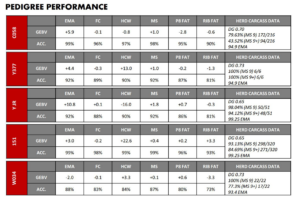
G 615’s Performance Pedigree
The elite next generation sires mentioned here, along with the Blackmore genomics program paints a bright future for not only the genetics program, but for the entire business. Blackmore Wagyu currently remains unable to fill the huge global demand for their beef. The quality of Blackmore genetics will be increasing ever more rapidly due to a shortening of the generational interval through genomics, driving the quality and profitability of their cattle and beef to increase. This only will help grow the global demand for their beef even further, therefore positioning Blackmore Wagyu to continue to be a global leader in premium fullblood Wagyu beef and genetics for years to come.




